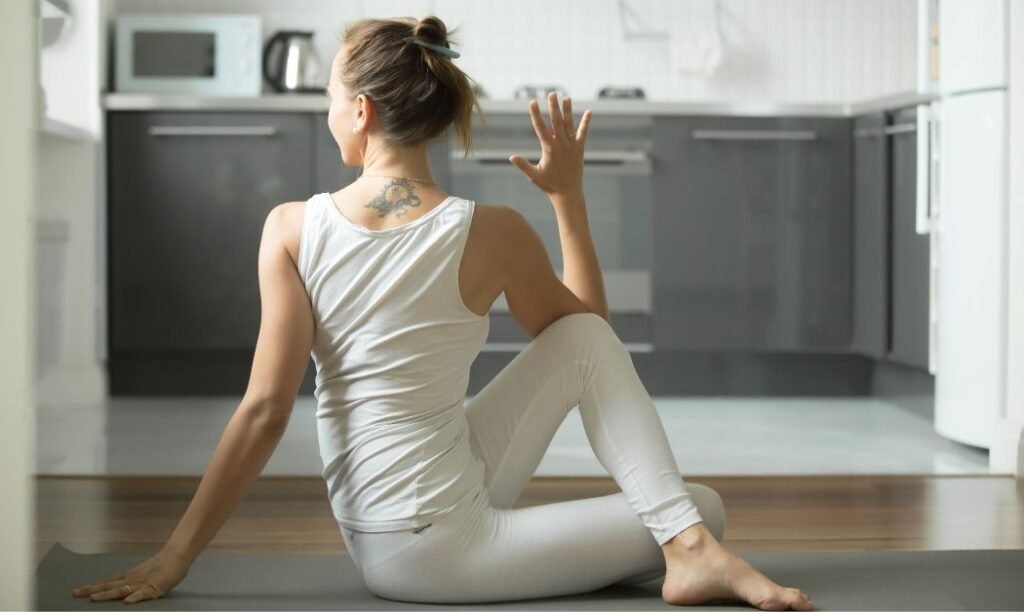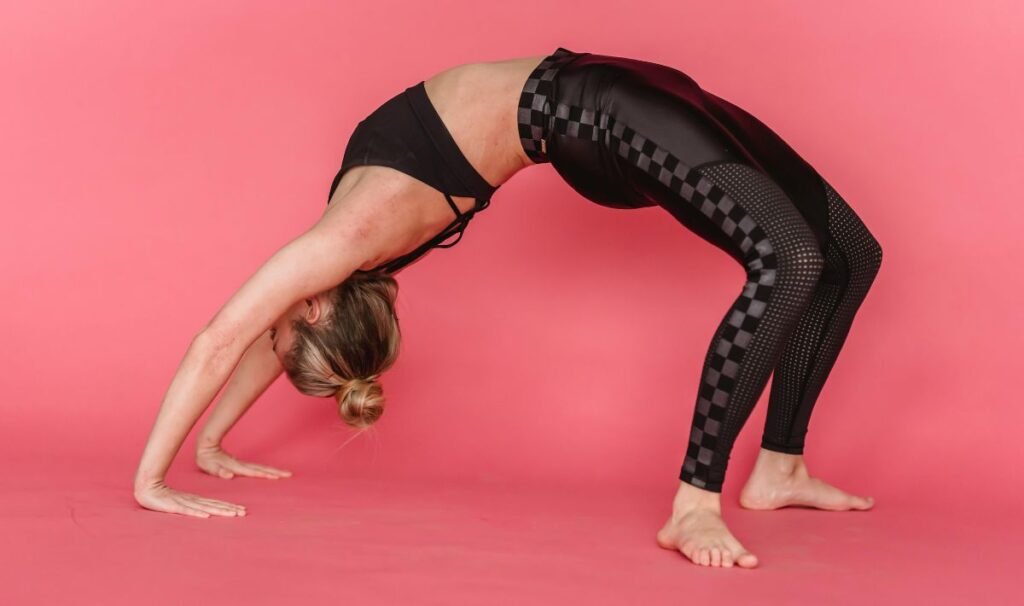Yoga is a wonderful way to connect your mind and body, bringing peace and balance to your daily life. Among the many poses that yoga offers, the Half Lotus Pose, or Ardha Padmasana, stands out for its simplicity and profound benefits. In this guide, we’ll explore everything you need to know about the Half Lotus Pose—from how to do it properly, its numerous benefits, tips to improve, and exciting variations to try.
What Is the Half Lotus Pose?
The Half Lotus Pose is a beginner-friendly variation of the full Lotus Pose (padmasana), a classic seated meditation posture in yoga. Ardha Padmasana involves placing one foot on the opposite thigh. At the same time, the other leg remains on the floor in a cross-legged position. It is a comfortable and accessible position that helps prepare the body for deeper meditation practices.
Why Choose the Half Lotus Pose?
If you’re looking for a pose that strikes a balance between comfort and challenge, the Half Lotus Pose is perfect. It’s an excellent option for beginners who find the full Lotus Pose too intense. The Half Lotus Pose offers many of the same benefits as the full version without straining the hips, knees, or ankles.
How to Perform the Half Lotus Pose (Ardha Padmasana)
Follow these simple steps to master the Half Lotus Pose:
- Find a Comfortable Space: Choose a quiet, flat area where you can sit without distractions. Use a yoga mat or a soft surface for added comfort.
- Begin in a Cross-Legged Position: Sit on the mat with your legs crossed naturally. Keep your back straight and shoulders relaxed.
- Position Your First Foot: Take your right foot and gently place it on top of your left thigh. Ensure the sole of your foot faces upward and the heel is close to your abdomen.
- Adjust Your Left Leg: Keep your left leg bent with the foot resting on the ground, under your right thigh.
- Check Your Posture: Straighten your spine, align your head with your neck, and rest your hands on your knees in a relaxed manner. You can use a mudra (hand gesture) like Chin Mudra for added focus.
- Hold and Breathe: Close your eyes and take deep, steady breaths. Hold the pose for as long as it feels comfortable, ideally starting with 1-2 minutes and gradually increasing over time.
- Switch Sides: Release the pose gently and repeat with the opposite leg on top.
Readmore: Perfect Your Staff Pose
Readmore: Half Lord of the Fishes Pose
Benefits
Practicing the Half Lotus Pose regularly can enhance your physical, mental, and emotional well-being. Here are some key benefits:
1 . Improves Flexibility
The pose gently stretches the hips, knees, and ankles, improving flexibility in these areas over time.
2. Enhances Posture
By encouraging a straight spine, Ardha Padmasana helps develop better posture and alignment.
3. Boosts Circulation
Sitting in the Half Lotus Pose promotes blood flow to the lower body, relieving stiffness and enhancing circulation.
4. Supports Meditation
The pose’s stability and comfort make it an ideal choice for meditation, helping you stay focused and centered.
5. Calms the Mind
Practicing this pose with deep breathing can reduce stress, anxiety, and mental fatigue.
Tips for Mastering the Half Lotus Pose
Here are some practical tips to make your Half Lotus experience even better:
- Warm Up First: Loosen up your hips and legs with stretches like Butterfly Pose or Seated Forward Bend.
- Use Props: Place a folded blanket or cushion under your hips for added support and comfort.
- Listen to Your Body: Avoid forcing your leg into position; over time, your flexibility will improve naturally.
- Focus on Breath: Deep, mindful breathing enhances the meditative aspect of the pose.
- Alternate Legs: Always switch sides to ensure balanced flexibility and strength.
Readmore: Reverse Tabletop Pose Simplified
Readmore: Mastering the Bird of Paradise Yoga Pose
Common Mistakes to Avoid
To get the most out of the Half Lotus Pose, avoid these common pitfalls:
- Hunching Your Back: Keep your spine straight to prevent strain and discomfort.
- Forcing the Stretch: Forcing your leg onto your thigh can lead to injuries. Always move gently.
- Ignoring Pain: Discomfort is normal, but sharp pain is a sign to stop immediately.
- Skipping Warm-Ups: Jumping straight into the pose without preparing your body can lead to stiffness and strain.
Variations
Once you’re comfortable with the basic Half Lotus Pose, try these variations to deepen your practice:
1 . Half Lotus with Forward Bend
- From Ardha Padmasana, lean forward and place your hands on the ground.
- Stretch your arms out and rest your forehead on the floor for a deeper hip stretch.
2. Half Lotus Twist
- In the Half Lotus Pose, place your right hand on your left knee and your left hand on the ground behind you.
- Twist gently to one side, keeping your back straight.
3. Dynamic Half Lotus Flow
- Alternate between sitting in the Half Lotus Pose and extending your legs straight out.
- This variation adds movement and builds strength.
4. Half Lotus with Mudras
- Incorporate different hand gestures like Gyan Mudra or Dhyana Mudra to enhance focus and energy flow.
Precautions and Contraindications
While the Half Lotus Pose is generally safe, certain precautions should be kept in mind:
- Avoid the pose if you have severe knee, hip, or ankle injuries.
- Consult a yoga instructor if you’re unsure about your alignment.
- Pregnant women should avoid this pose unless approved by a healthcare provider.
The Emotional Connection: Finding Peace in the Pose
Beyond its physical benefits, the Half Lotus Pose has a profound emotional impact. It’s a pose of grounding and centering, allowing you to connect with your inner self. Use this time to let go of stress, embrace stillness, and cultivate gratitude for your body and mind.
Readmore: Master the Half Pigeon Pose
Readmore: Master The Wind-Relieving Pose (Pavanamuktasana)
Final Thoughts
The Half Lotus Pose is a gateway to deeper yoga practice and self-discovery. Whether you’re a beginner or an experienced yogi, incorporating this pose into your routine can bring balance, flexibility, and tranquility. Remember, yoga is about progress, not perfection, so be patient with yourself as you grow.
Ready to give the Half Lotus Pose a try? Roll out your mat, take a deep breath, and let the journey begin!
Related Article :
*Fallen Triangle Pose for Strength, Balance, and Flexibility
*How to Do Easy Pose (Sukhasana)

Sonu is a passionate yoga teacher with over 6+ years of experience helping individuals find balance, strength, and inner peace through the transformative power of yoga. As the creator of Pure Yoga Vibes, Sonu shares expert insights, inspiring practices, and a wealth of knowledge to support your wellness journey. Dedicated to creating a space for growth and mindfulness, Sonu’s mission is to make yoga accessible and enjoyable for everyone. For inquiries or collaborations, feel free to reach out at contact@pureyogavibes.com.



